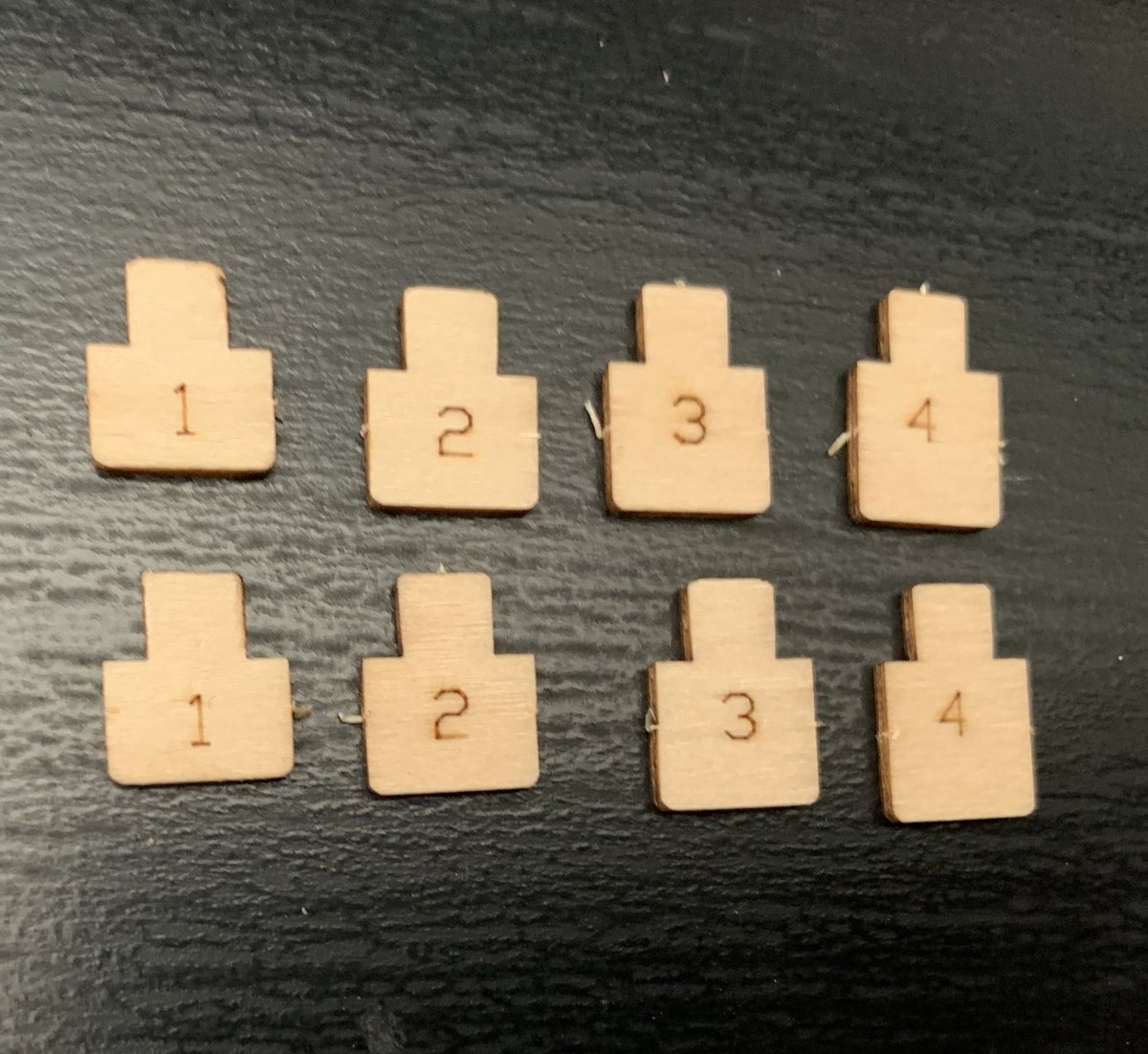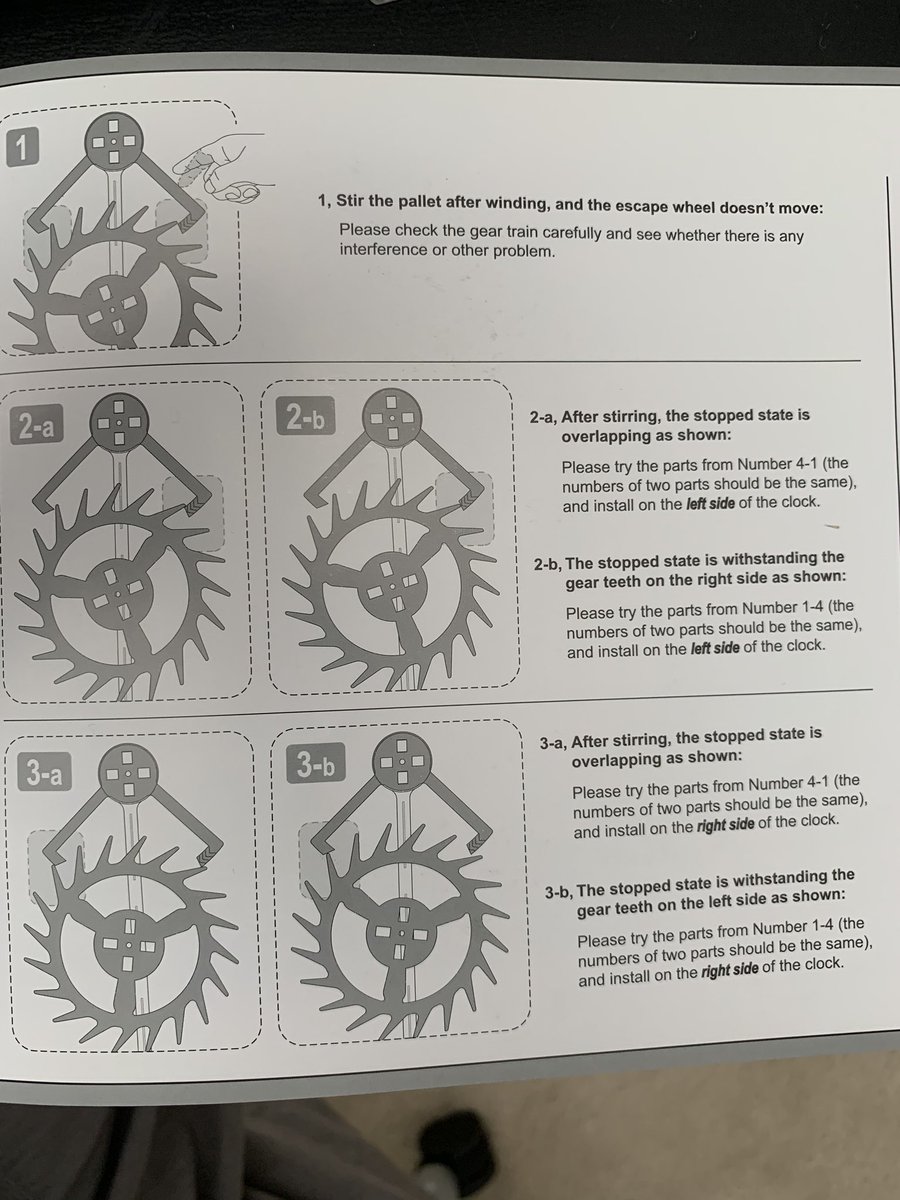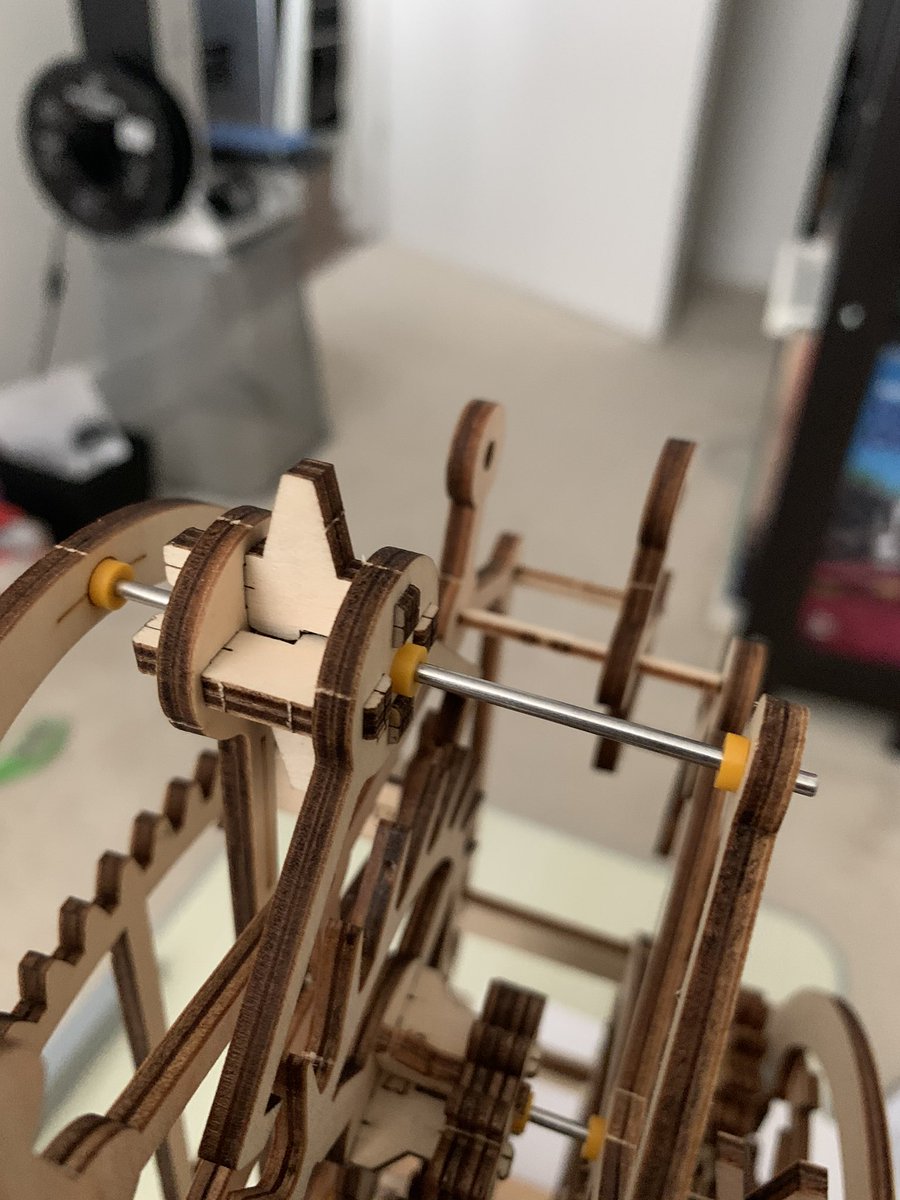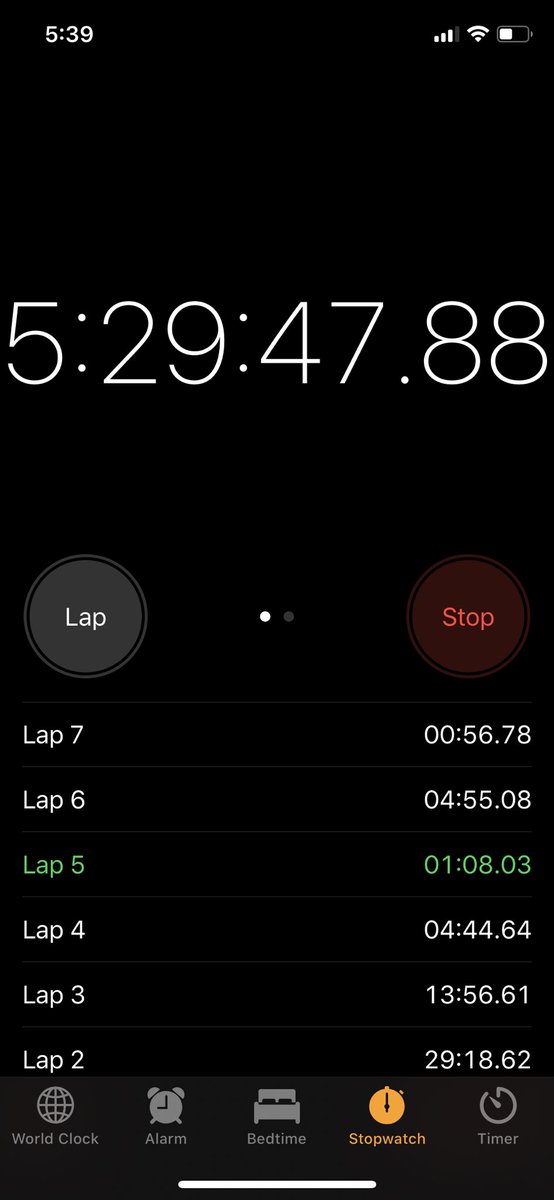Finished assembling my clock but it stops after like 5 tick ticks  https://abs.twimg.com/emoji/v2/... draggable="false" alt="😖" title="Verblüfftes Gesicht" aria-label="Emoji: Verblüfftes Gesicht">
https://abs.twimg.com/emoji/v2/... draggable="false" alt="😖" title="Verblüfftes Gesicht" aria-label="Emoji: Verblüfftes Gesicht">
It’s a very sensitive leveling issue now. I’m up to 30s continuous ticking.
The leveling mechanism is kinda silly: a set of four pairs of wooden lifting pegs. The instructions tell you which side to raise depending on where the tooth on the escape wheel stops relative to rocker. I’m using sheets of paper to adjust. Gonna add leveling scenes instead.
Ok got up to 45 seconds. Now I know what the problem is. I’m calling this project done and triggering a new one: Project Clock Leveling.
3d printed shoes with leveling screws screw for the clock may be involved.
3d printed shoes with leveling screws screw for the clock may be involved.
For those interested, a buddy of mine in grad school wrote a paper on the control mechanism of clock escapements. It is surprisingly complex. https://www.tandfonline.com/doi/abs/10.1080/00207170310001632412">https://www.tandfonline.com/doi/abs/1...
Mechanical clocks are among the technologies that are easier to build in practice than model and theorize.
Fascinating that the tick-tick sound is different depending on the level adjustment. It is most pleasantly symmetric in an aural sense when it is most level.
Still trouble-shooting this. The gear train is now fine. Goes brrr when I disengage the pendulum rocker. The mainspring drive mechanism is really quite beautiful. The rocker is delicately balanced to both stop it rom going brrr and get energy from it.
I think the rocker is poorly aligned due to a plane offset error. Which I made worse during my disengagement test. The contact has to generate enough force to overcome rocker contact friction.
I don’t think it’s a leveling error now since I can get it to about 30s ticking in either direction.
Up to 55 seconds now. If I can beat this plane alignment I think I’m good.
1 minute 40 seconds!
Okay, over 5 minutes... it was the contact offset. It’s basically solved now. The pendulum/rocker was off by like 3 mm along its axle. We’re in continuous ticking now. Need to fine tune a bit but the leveling is not that sensitive. With the proper contact it goes long.
It’s been going for 15 minutes now
*looking around super-impressed with myself*
Wtf. Pendulum regulated gear trains driven by mainsprings are an amazing invention. Now I want to do more with this idea.
*looking around super-impressed with myself*
Wtf. Pendulum regulated gear trains driven by mainsprings are an amazing invention. Now I want to do more with this idea.
Stopped after half an hour because a gear axis slipped out of sleeve and then wouldn’t start up again properly. Turned out it’s wound down too much with all this tinkering so had to rewind. Ticking again. Once I get it going for a full spring winding cycle I’ll work on accuracy.
What’s really clever is that the contact forces generated by a 1s pendulum would be too weak to directly compete with a powerful mainspring. But the ~ 2 orders of magnitude gear reduction creates enough mechanical advantage that the 1s pendulum can regulate it
Ie the gear down to generate minutes/hours to tell time is also what creates the leverage to control the dynamics. The range this trick works goes from Big Ben to desktop size. And then you switch to a balance wheel oscillator instead of gravity, to go down to wristwatch size.
I’ll write this up as part 2 of my clockmaking blogchain, here’s part 1. Highly recommend this ROKR kit. Commune with Galileo and Huygens for under 50 bucks. https://www.ribbonfarm.com/2020/08/13/clockmaking-1/">https://www.ribbonfarm.com/2020/08/1...
Today, for the first time, it’s been going continuously for over an hour without stopping, after some fairly brutal microsurgery on the gear train.
Sometimes you gotta brute force this shit a bit
Sometimes you gotta brute force this shit a bit
2 hours and counting. Holy crap there’s a small chance this will run a full 24h. Afaict I’ve bullied all the frictions into submission. Fingers crossed  https://abs.twimg.com/emoji/v2/... draggable="false" alt="🤞" title="Crossed fingers" aria-label="Emoji: Crossed fingers">
https://abs.twimg.com/emoji/v2/... draggable="false" alt="🤞" title="Crossed fingers" aria-label="Emoji: Crossed fingers">
3 hours
Since it& #39;s a mechanical clock, 12 hours is the full cycle test. If it makes it past 12, there& #39;s no sticky bits anywhere in the gear train. Interesting... just hit me that since such clocks are typically meant to be wound every day, each windup is n=2 full cycles.
If it makes it, I& #39;ll do a final light tightening of all wobbly bits, maybe paint some fluorescent numbers on the dials and hands, and put it up on a shelf.
Dammit. Stopped at 4.5h. And now cat is rubbing aggressively against table it’s on. Not out of the woods yet.
I& #39;m going to have to resist the temptation to fight this endlessly. I mean this is laser-cut wood, push-fit assembled. Still, getting it to run a full spring-wind-down seems like not too much to ask. I don& #39;t need perfection. Just outlast the unwind.
Rube Goldberg Chindogu idea... attach an arduino meta-control loop that notices if it stops via optical sensor interrupted by the pendulum, and gives the rocker a li& #39;l kick if it does
I think the cat is jealous of the clock
Anyone who gets this kit built and ticking smoothly on first attempt is some sort of mechanical genius. I’ve gone: 10s, 30s, 55s, 5 minutes, 25 minutes, 55 minutes, 4.5 hours, and now back to 20-30 min range.
I suspect it’s the spring force wind-down.
I suspect it’s the spring force wind-down.
Yup. Rewound to full tightness and it’s going steadily again. I may be down in the noise zone of friction. It’s not a specific sticking point. To test this, I’d have to note all gear positions at each stall. Should be uniform random?
I’ll measure this, but after first stall at 4:30, with each gentle impulse on rocker it went for a shorter interval each time. By the time it was ~1 minute, strength of initial impulse was determining the duration so pendulum was driving, not spring.
I’m sciencing the shit out of this problem that Huygens cracked in 1658  https://abs.twimg.com/emoji/v2/... draggable="false" alt="😎" title="Lächelndes Gesicht mit Sonnenbrille" aria-label="Emoji: Lächelndes Gesicht mit Sonnenbrille">
https://abs.twimg.com/emoji/v2/... draggable="false" alt="😎" title="Lächelndes Gesicht mit Sonnenbrille" aria-label="Emoji: Lächelndes Gesicht mit Sonnenbrille">
Bringing up the rear of the scientific revolution like a boss.
Bringing up the rear of the scientific revolution like a boss.
Looks like the spring is maybe not actually designed for 24h  https://abs.twimg.com/emoji/v2/... draggable="false" alt="😬" title="Grimasse schneidendes Gesicht" aria-label="Emoji: Grimasse schneidendes Gesicht">
https://abs.twimg.com/emoji/v2/... draggable="false" alt="😬" title="Grimasse schneidendes Gesicht" aria-label="Emoji: Grimasse schneidendes Gesicht">
Well let’s see how long I can get it to run, and how much energy is left in the spring when it runs out.
I’m guessing 5-6h with my slightly shoddy assembly, maybe 10-12 if perfectly assembled. https://twitter.com/knipps/status/1306438464175403008">https://twitter.com/knipps/st...
Well let’s see how long I can get it to run, and how much energy is left in the spring when it runs out.
I’m guessing 5-6h with my slightly shoddy assembly, maybe 10-12 if perfectly assembled. https://twitter.com/knipps/status/1306438464175403008">https://twitter.com/knipps/st...

 Read on Twitter
Read on Twitter



 Bringing up the rear of the scientific revolution like a boss." title="I’m sciencing the shit out of this problem that Huygens cracked in 1658 https://abs.twimg.com/emoji/v2/... draggable="false" alt="😎" title="Lächelndes Gesicht mit Sonnenbrille" aria-label="Emoji: Lächelndes Gesicht mit Sonnenbrille">Bringing up the rear of the scientific revolution like a boss." class="img-responsive" style="max-width:100%;"/>
Bringing up the rear of the scientific revolution like a boss." title="I’m sciencing the shit out of this problem that Huygens cracked in 1658 https://abs.twimg.com/emoji/v2/... draggable="false" alt="😎" title="Lächelndes Gesicht mit Sonnenbrille" aria-label="Emoji: Lächelndes Gesicht mit Sonnenbrille">Bringing up the rear of the scientific revolution like a boss." class="img-responsive" style="max-width:100%;"/>


